Case Study: Analyzing The Wellness Wheel in Healthcare
VerifiedAdded on 2023/01/23
|12
|2368
|41
Case Study
AI Summary
This case study analyzes Jason's situation, who was involved in a car accident, to illustrate the impact of physical, emotional, and social factors on overall wellness. The study uses the Wellness Wheel model to demonstrate how imbalances in one area can affect other aspects of a person's life, including spiritual, financial, environmental, intellectual, and social components. It examines the biopsychosocial factors influencing Jason's health and explores how his physical pain, emotional stress, and social support systems affect his well-being. The study also proposes a psychoeducational approach to address Jason's challenges, including interventions such as engaging supportive healthcare providers, integrating him into social groups, and strengthening his personal protective factors. The goal is to improve Jason's health outcomes and increase his ability to cope with the challenges and the case study concludes by emphasizing the interconnectedness of wellness components and the value of proactive intervention strategies.
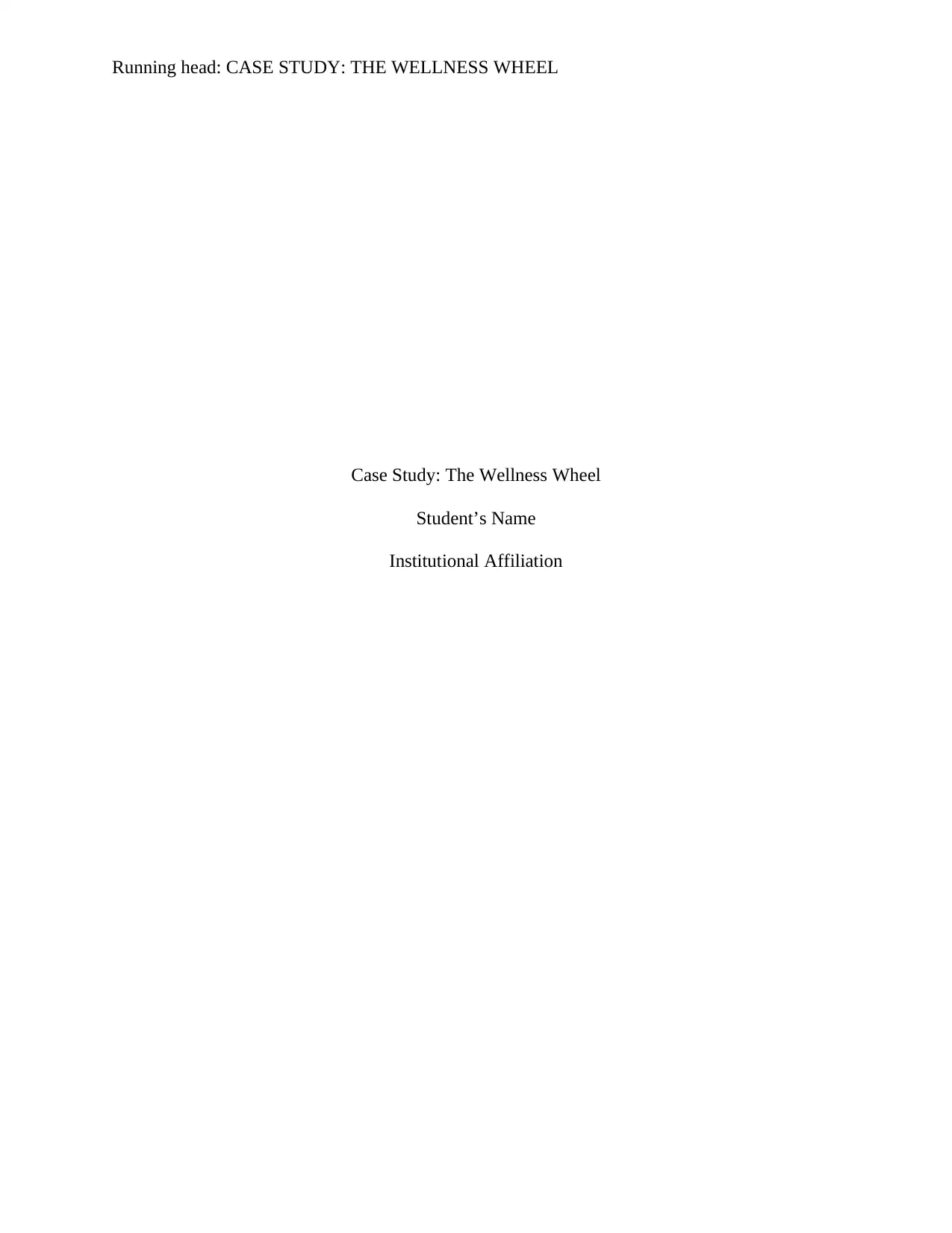
Running head: CASE STUDY: THE WELLNESS WHEEL
Case Study: The Wellness Wheel
Student’s Name
Institutional Affiliation
Case Study: The Wellness Wheel
Student’s Name
Institutional Affiliation
Paraphrase This Document
Need a fresh take? Get an instant paraphrase of this document with our AI Paraphraser
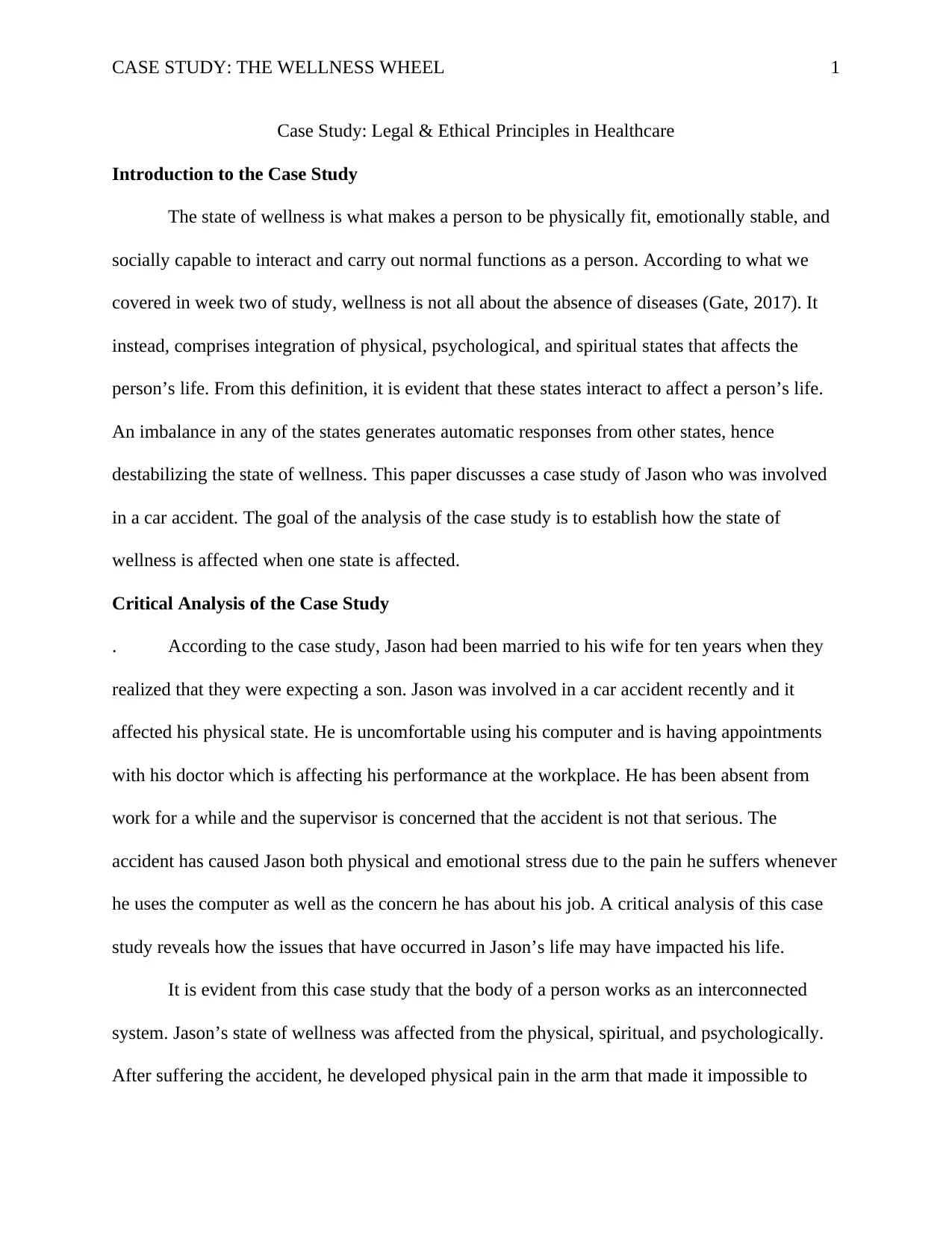
CASE STUDY: THE WELLNESS WHEEL 1
Case Study: Legal & Ethical Principles in Healthcare
Introduction to the Case Study
The state of wellness is what makes a person to be physically fit, emotionally stable, and
socially capable to interact and carry out normal functions as a person. According to what we
covered in week two of study, wellness is not all about the absence of diseases (Gate, 2017). It
instead, comprises integration of physical, psychological, and spiritual states that affects the
person’s life. From this definition, it is evident that these states interact to affect a person’s life.
An imbalance in any of the states generates automatic responses from other states, hence
destabilizing the state of wellness. This paper discusses a case study of Jason who was involved
in a car accident. The goal of the analysis of the case study is to establish how the state of
wellness is affected when one state is affected.
Critical Analysis of the Case Study
. According to the case study, Jason had been married to his wife for ten years when they
realized that they were expecting a son. Jason was involved in a car accident recently and it
affected his physical state. He is uncomfortable using his computer and is having appointments
with his doctor which is affecting his performance at the workplace. He has been absent from
work for a while and the supervisor is concerned that the accident is not that serious. The
accident has caused Jason both physical and emotional stress due to the pain he suffers whenever
he uses the computer as well as the concern he has about his job. A critical analysis of this case
study reveals how the issues that have occurred in Jason’s life may have impacted his life.
It is evident from this case study that the body of a person works as an interconnected
system. Jason’s state of wellness was affected from the physical, spiritual, and psychologically.
After suffering the accident, he developed physical pain in the arm that made it impossible to
Case Study: Legal & Ethical Principles in Healthcare
Introduction to the Case Study
The state of wellness is what makes a person to be physically fit, emotionally stable, and
socially capable to interact and carry out normal functions as a person. According to what we
covered in week two of study, wellness is not all about the absence of diseases (Gate, 2017). It
instead, comprises integration of physical, psychological, and spiritual states that affects the
person’s life. From this definition, it is evident that these states interact to affect a person’s life.
An imbalance in any of the states generates automatic responses from other states, hence
destabilizing the state of wellness. This paper discusses a case study of Jason who was involved
in a car accident. The goal of the analysis of the case study is to establish how the state of
wellness is affected when one state is affected.
Critical Analysis of the Case Study
. According to the case study, Jason had been married to his wife for ten years when they
realized that they were expecting a son. Jason was involved in a car accident recently and it
affected his physical state. He is uncomfortable using his computer and is having appointments
with his doctor which is affecting his performance at the workplace. He has been absent from
work for a while and the supervisor is concerned that the accident is not that serious. The
accident has caused Jason both physical and emotional stress due to the pain he suffers whenever
he uses the computer as well as the concern he has about his job. A critical analysis of this case
study reveals how the issues that have occurred in Jason’s life may have impacted his life.
It is evident from this case study that the body of a person works as an interconnected
system. Jason’s state of wellness was affected from the physical, spiritual, and psychologically.
After suffering the accident, he developed physical pain in the arm that made it impossible to
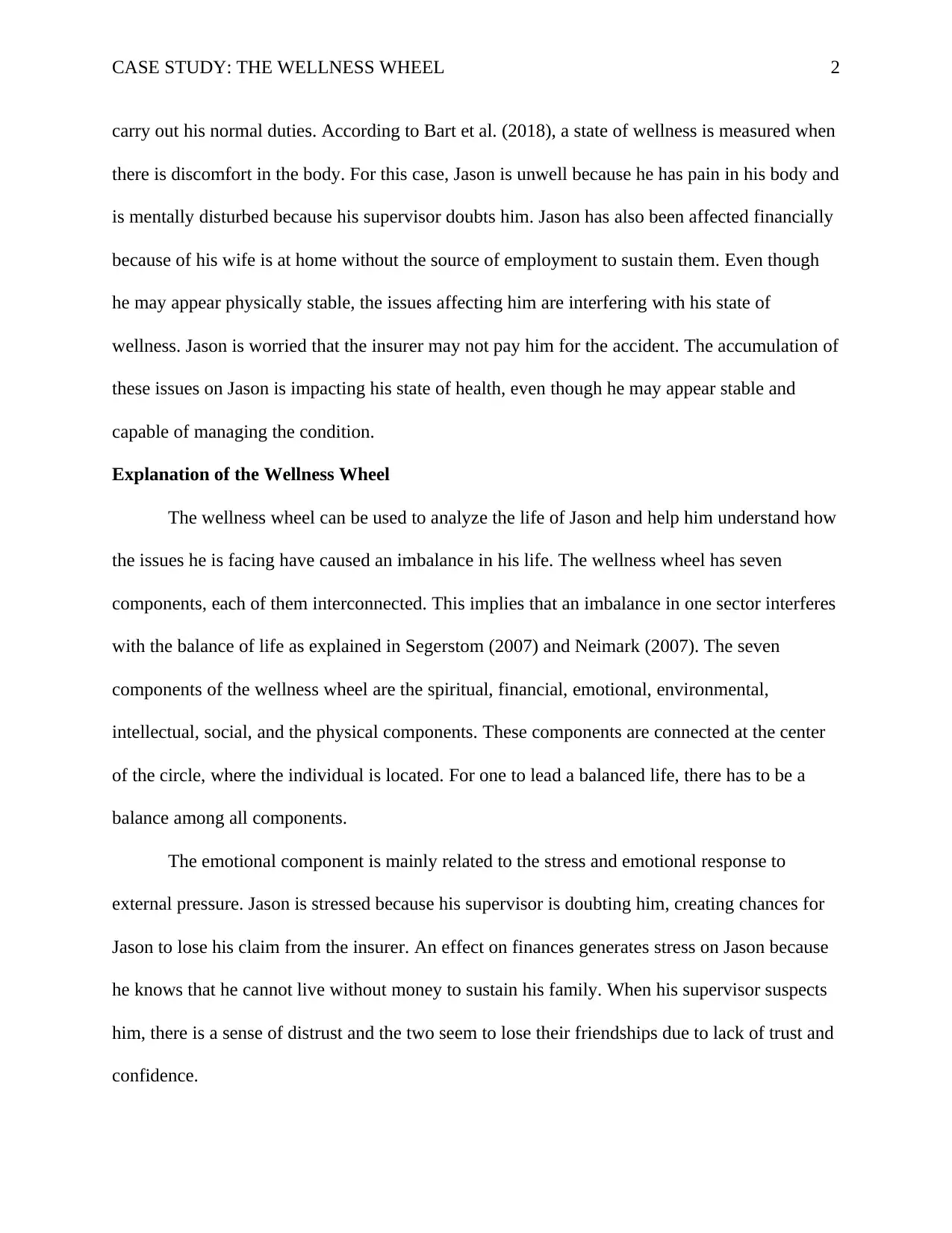
CASE STUDY: THE WELLNESS WHEEL 2
carry out his normal duties. According to Bart et al. (2018), a state of wellness is measured when
there is discomfort in the body. For this case, Jason is unwell because he has pain in his body and
is mentally disturbed because his supervisor doubts him. Jason has also been affected financially
because of his wife is at home without the source of employment to sustain them. Even though
he may appear physically stable, the issues affecting him are interfering with his state of
wellness. Jason is worried that the insurer may not pay him for the accident. The accumulation of
these issues on Jason is impacting his state of health, even though he may appear stable and
capable of managing the condition.
Explanation of the Wellness Wheel
The wellness wheel can be used to analyze the life of Jason and help him understand how
the issues he is facing have caused an imbalance in his life. The wellness wheel has seven
components, each of them interconnected. This implies that an imbalance in one sector interferes
with the balance of life as explained in Segerstom (2007) and Neimark (2007). The seven
components of the wellness wheel are the spiritual, financial, emotional, environmental,
intellectual, social, and the physical components. These components are connected at the center
of the circle, where the individual is located. For one to lead a balanced life, there has to be a
balance among all components.
The emotional component is mainly related to the stress and emotional response to
external pressure. Jason is stressed because his supervisor is doubting him, creating chances for
Jason to lose his claim from the insurer. An effect on finances generates stress on Jason because
he knows that he cannot live without money to sustain his family. When his supervisor suspects
him, there is a sense of distrust and the two seem to lose their friendships due to lack of trust and
confidence.
carry out his normal duties. According to Bart et al. (2018), a state of wellness is measured when
there is discomfort in the body. For this case, Jason is unwell because he has pain in his body and
is mentally disturbed because his supervisor doubts him. Jason has also been affected financially
because of his wife is at home without the source of employment to sustain them. Even though
he may appear physically stable, the issues affecting him are interfering with his state of
wellness. Jason is worried that the insurer may not pay him for the accident. The accumulation of
these issues on Jason is impacting his state of health, even though he may appear stable and
capable of managing the condition.
Explanation of the Wellness Wheel
The wellness wheel can be used to analyze the life of Jason and help him understand how
the issues he is facing have caused an imbalance in his life. The wellness wheel has seven
components, each of them interconnected. This implies that an imbalance in one sector interferes
with the balance of life as explained in Segerstom (2007) and Neimark (2007). The seven
components of the wellness wheel are the spiritual, financial, emotional, environmental,
intellectual, social, and the physical components. These components are connected at the center
of the circle, where the individual is located. For one to lead a balanced life, there has to be a
balance among all components.
The emotional component is mainly related to the stress and emotional response to
external pressure. Jason is stressed because his supervisor is doubting him, creating chances for
Jason to lose his claim from the insurer. An effect on finances generates stress on Jason because
he knows that he cannot live without money to sustain his family. When his supervisor suspects
him, there is a sense of distrust and the two seem to lose their friendships due to lack of trust and
confidence.
⊘ This is a preview!⊘
Do you want full access?
Subscribe today to unlock all pages.

Trusted by 1+ million students worldwide
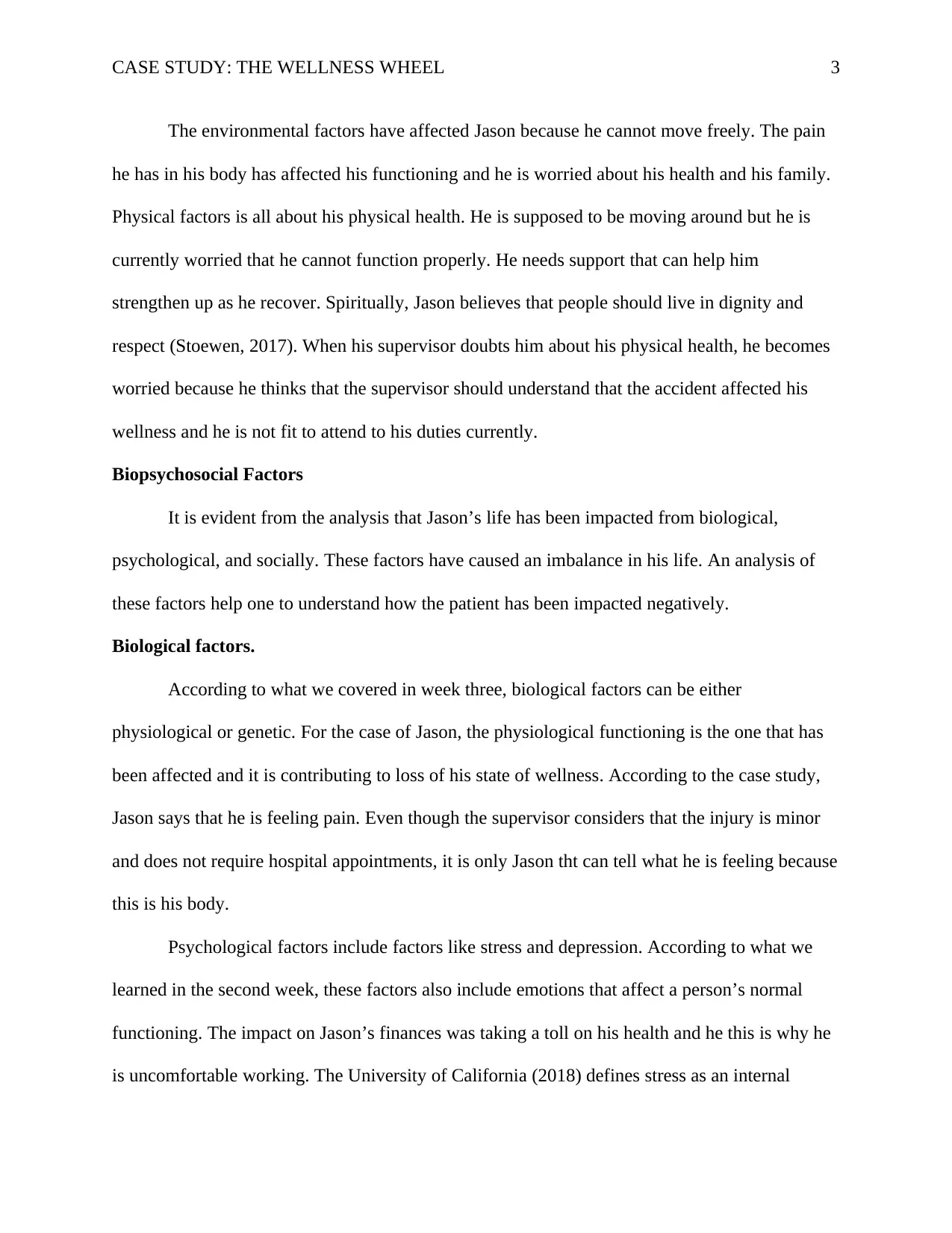
CASE STUDY: THE WELLNESS WHEEL 3
The environmental factors have affected Jason because he cannot move freely. The pain
he has in his body has affected his functioning and he is worried about his health and his family.
Physical factors is all about his physical health. He is supposed to be moving around but he is
currently worried that he cannot function properly. He needs support that can help him
strengthen up as he recover. Spiritually, Jason believes that people should live in dignity and
respect (Stoewen, 2017). When his supervisor doubts him about his physical health, he becomes
worried because he thinks that the supervisor should understand that the accident affected his
wellness and he is not fit to attend to his duties currently.
Biopsychosocial Factors
It is evident from the analysis that Jason’s life has been impacted from biological,
psychological, and socially. These factors have caused an imbalance in his life. An analysis of
these factors help one to understand how the patient has been impacted negatively.
Biological factors.
According to what we covered in week three, biological factors can be either
physiological or genetic. For the case of Jason, the physiological functioning is the one that has
been affected and it is contributing to loss of his state of wellness. According to the case study,
Jason says that he is feeling pain. Even though the supervisor considers that the injury is minor
and does not require hospital appointments, it is only Jason tht can tell what he is feeling because
this is his body.
Psychological factors include factors like stress and depression. According to what we
learned in the second week, these factors also include emotions that affect a person’s normal
functioning. The impact on Jason’s finances was taking a toll on his health and he this is why he
is uncomfortable working. The University of California (2018) defines stress as an internal
The environmental factors have affected Jason because he cannot move freely. The pain
he has in his body has affected his functioning and he is worried about his health and his family.
Physical factors is all about his physical health. He is supposed to be moving around but he is
currently worried that he cannot function properly. He needs support that can help him
strengthen up as he recover. Spiritually, Jason believes that people should live in dignity and
respect (Stoewen, 2017). When his supervisor doubts him about his physical health, he becomes
worried because he thinks that the supervisor should understand that the accident affected his
wellness and he is not fit to attend to his duties currently.
Biopsychosocial Factors
It is evident from the analysis that Jason’s life has been impacted from biological,
psychological, and socially. These factors have caused an imbalance in his life. An analysis of
these factors help one to understand how the patient has been impacted negatively.
Biological factors.
According to what we covered in week three, biological factors can be either
physiological or genetic. For the case of Jason, the physiological functioning is the one that has
been affected and it is contributing to loss of his state of wellness. According to the case study,
Jason says that he is feeling pain. Even though the supervisor considers that the injury is minor
and does not require hospital appointments, it is only Jason tht can tell what he is feeling because
this is his body.
Psychological factors include factors like stress and depression. According to what we
learned in the second week, these factors also include emotions that affect a person’s normal
functioning. The impact on Jason’s finances was taking a toll on his health and he this is why he
is uncomfortable working. The University of California (2018) defines stress as an internal
Paraphrase This Document
Need a fresh take? Get an instant paraphrase of this document with our AI Paraphraser
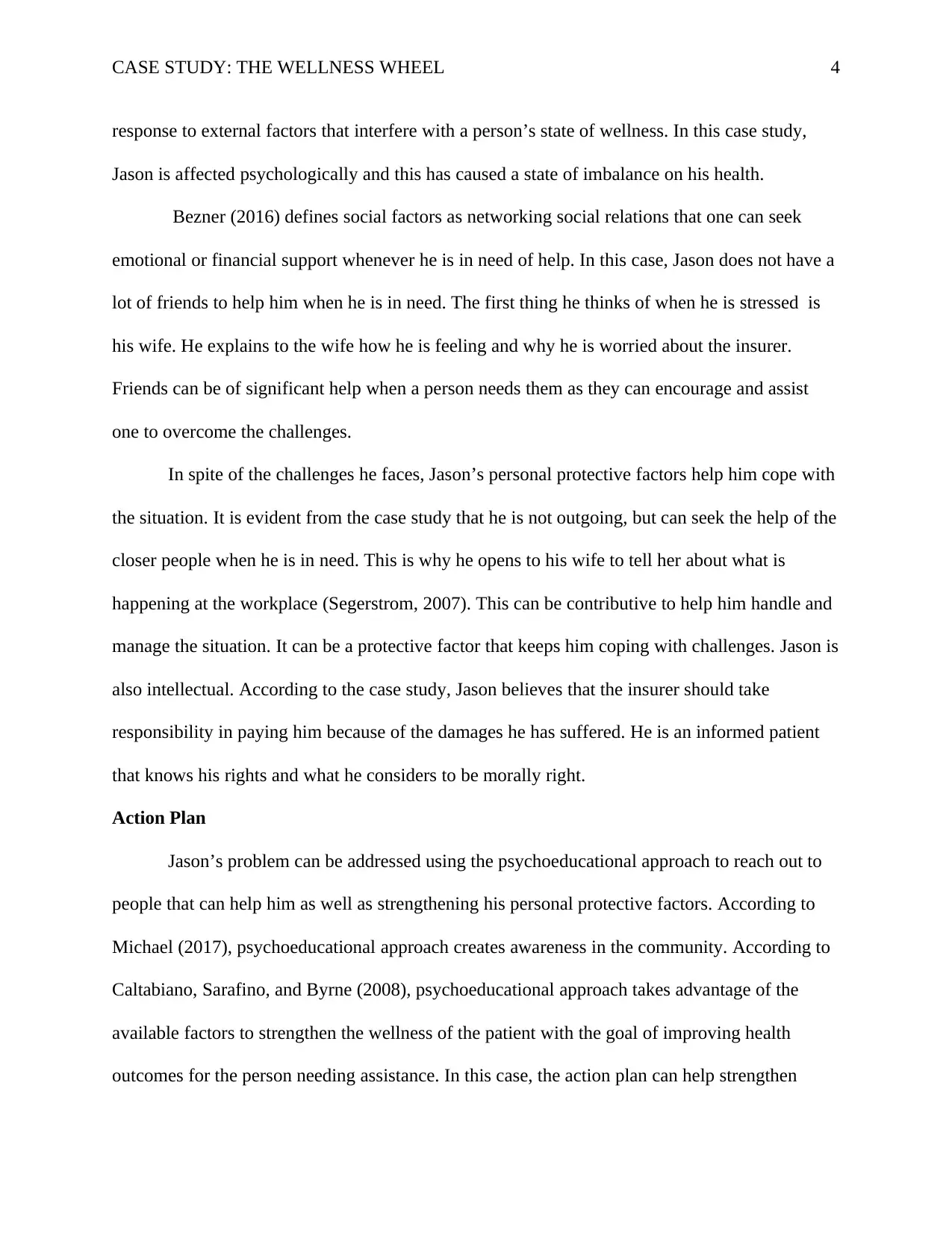
CASE STUDY: THE WELLNESS WHEEL 4
response to external factors that interfere with a person’s state of wellness. In this case study,
Jason is affected psychologically and this has caused a state of imbalance on his health.
Bezner (2016) defines social factors as networking social relations that one can seek
emotional or financial support whenever he is in need of help. In this case, Jason does not have a
lot of friends to help him when he is in need. The first thing he thinks of when he is stressed is
his wife. He explains to the wife how he is feeling and why he is worried about the insurer.
Friends can be of significant help when a person needs them as they can encourage and assist
one to overcome the challenges.
In spite of the challenges he faces, Jason’s personal protective factors help him cope with
the situation. It is evident from the case study that he is not outgoing, but can seek the help of the
closer people when he is in need. This is why he opens to his wife to tell her about what is
happening at the workplace (Segerstrom, 2007). This can be contributive to help him handle and
manage the situation. It can be a protective factor that keeps him coping with challenges. Jason is
also intellectual. According to the case study, Jason believes that the insurer should take
responsibility in paying him because of the damages he has suffered. He is an informed patient
that knows his rights and what he considers to be morally right.
Action Plan
Jason’s problem can be addressed using the psychoeducational approach to reach out to
people that can help him as well as strengthening his personal protective factors. According to
Michael (2017), psychoeducational approach creates awareness in the community. According to
Caltabiano, Sarafino, and Byrne (2008), psychoeducational approach takes advantage of the
available factors to strengthen the wellness of the patient with the goal of improving health
outcomes for the person needing assistance. In this case, the action plan can help strengthen
response to external factors that interfere with a person’s state of wellness. In this case study,
Jason is affected psychologically and this has caused a state of imbalance on his health.
Bezner (2016) defines social factors as networking social relations that one can seek
emotional or financial support whenever he is in need of help. In this case, Jason does not have a
lot of friends to help him when he is in need. The first thing he thinks of when he is stressed is
his wife. He explains to the wife how he is feeling and why he is worried about the insurer.
Friends can be of significant help when a person needs them as they can encourage and assist
one to overcome the challenges.
In spite of the challenges he faces, Jason’s personal protective factors help him cope with
the situation. It is evident from the case study that he is not outgoing, but can seek the help of the
closer people when he is in need. This is why he opens to his wife to tell her about what is
happening at the workplace (Segerstrom, 2007). This can be contributive to help him handle and
manage the situation. It can be a protective factor that keeps him coping with challenges. Jason is
also intellectual. According to the case study, Jason believes that the insurer should take
responsibility in paying him because of the damages he has suffered. He is an informed patient
that knows his rights and what he considers to be morally right.
Action Plan
Jason’s problem can be addressed using the psychoeducational approach to reach out to
people that can help him as well as strengthening his personal protective factors. According to
Michael (2017), psychoeducational approach creates awareness in the community. According to
Caltabiano, Sarafino, and Byrne (2008), psychoeducational approach takes advantage of the
available factors to strengthen the wellness of the patient with the goal of improving health
outcomes for the person needing assistance. In this case, the action plan can help strengthen
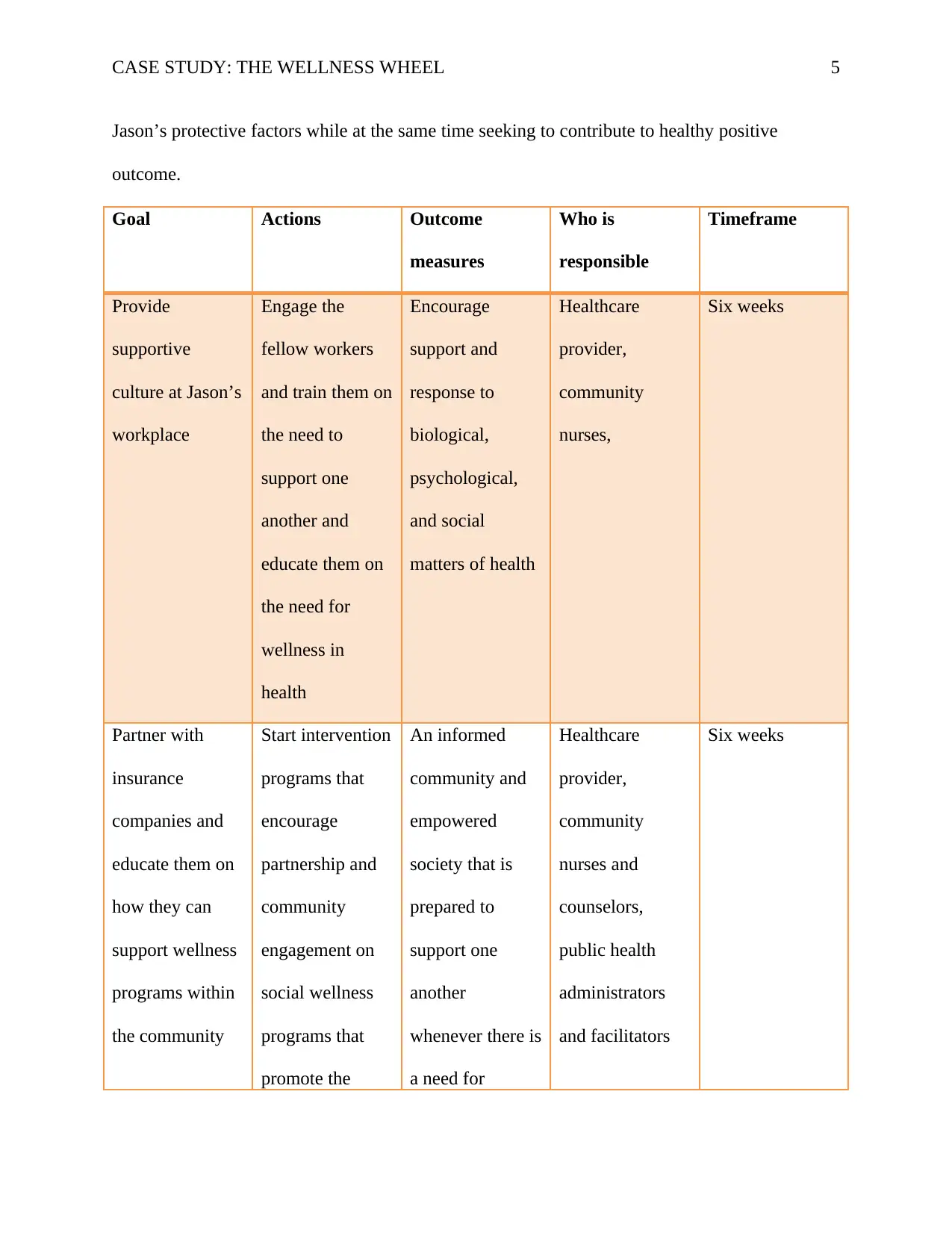
CASE STUDY: THE WELLNESS WHEEL 5
Jason’s protective factors while at the same time seeking to contribute to healthy positive
outcome.
Goal Actions Outcome
measures
Who is
responsible
Timeframe
Provide
supportive
culture at Jason’s
workplace
Engage the
fellow workers
and train them on
the need to
support one
another and
educate them on
the need for
wellness in
health
Encourage
support and
response to
biological,
psychological,
and social
matters of health
Healthcare
provider,
community
nurses,
Six weeks
Partner with
insurance
companies and
educate them on
how they can
support wellness
programs within
the community
Start intervention
programs that
encourage
partnership and
community
engagement on
social wellness
programs that
promote the
An informed
community and
empowered
society that is
prepared to
support one
another
whenever there is
a need for
Healthcare
provider,
community
nurses and
counselors,
public health
administrators
and facilitators
Six weeks
Jason’s protective factors while at the same time seeking to contribute to healthy positive
outcome.
Goal Actions Outcome
measures
Who is
responsible
Timeframe
Provide
supportive
culture at Jason’s
workplace
Engage the
fellow workers
and train them on
the need to
support one
another and
educate them on
the need for
wellness in
health
Encourage
support and
response to
biological,
psychological,
and social
matters of health
Healthcare
provider,
community
nurses,
Six weeks
Partner with
insurance
companies and
educate them on
how they can
support wellness
programs within
the community
Start intervention
programs that
encourage
partnership and
community
engagement on
social wellness
programs that
promote the
An informed
community and
empowered
society that is
prepared to
support one
another
whenever there is
a need for
Healthcare
provider,
community
nurses and
counselors,
public health
administrators
and facilitators
Six weeks
⊘ This is a preview!⊘
Do you want full access?
Subscribe today to unlock all pages.

Trusted by 1+ million students worldwide
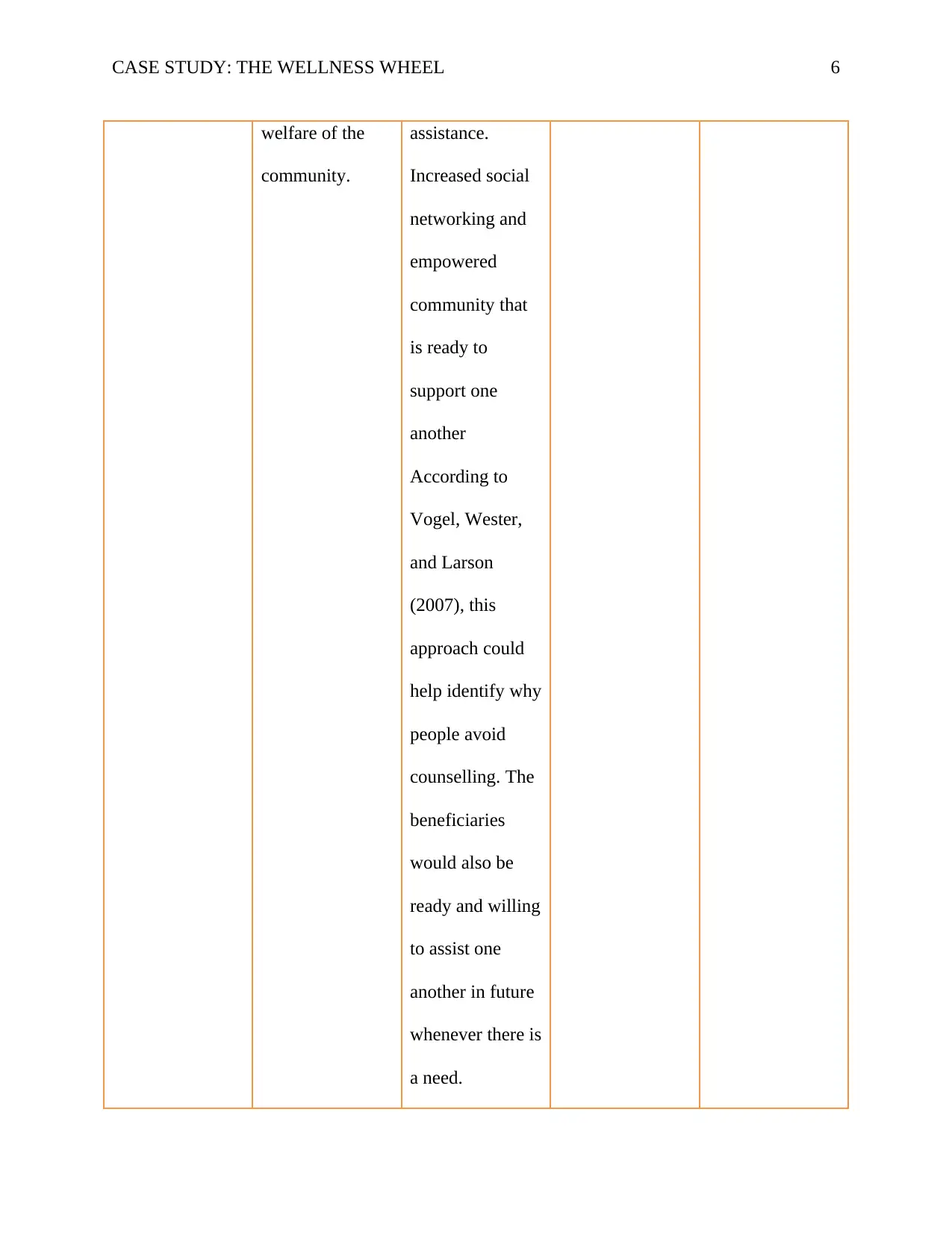
CASE STUDY: THE WELLNESS WHEEL 6
welfare of the
community.
assistance.
Increased social
networking and
empowered
community that
is ready to
support one
another
According to
Vogel, Wester,
and Larson
(2007), this
approach could
help identify why
people avoid
counselling. The
beneficiaries
would also be
ready and willing
to assist one
another in future
whenever there is
a need.
welfare of the
community.
assistance.
Increased social
networking and
empowered
community that
is ready to
support one
another
According to
Vogel, Wester,
and Larson
(2007), this
approach could
help identify why
people avoid
counselling. The
beneficiaries
would also be
ready and willing
to assist one
another in future
whenever there is
a need.
Paraphrase This Document
Need a fresh take? Get an instant paraphrase of this document with our AI Paraphraser
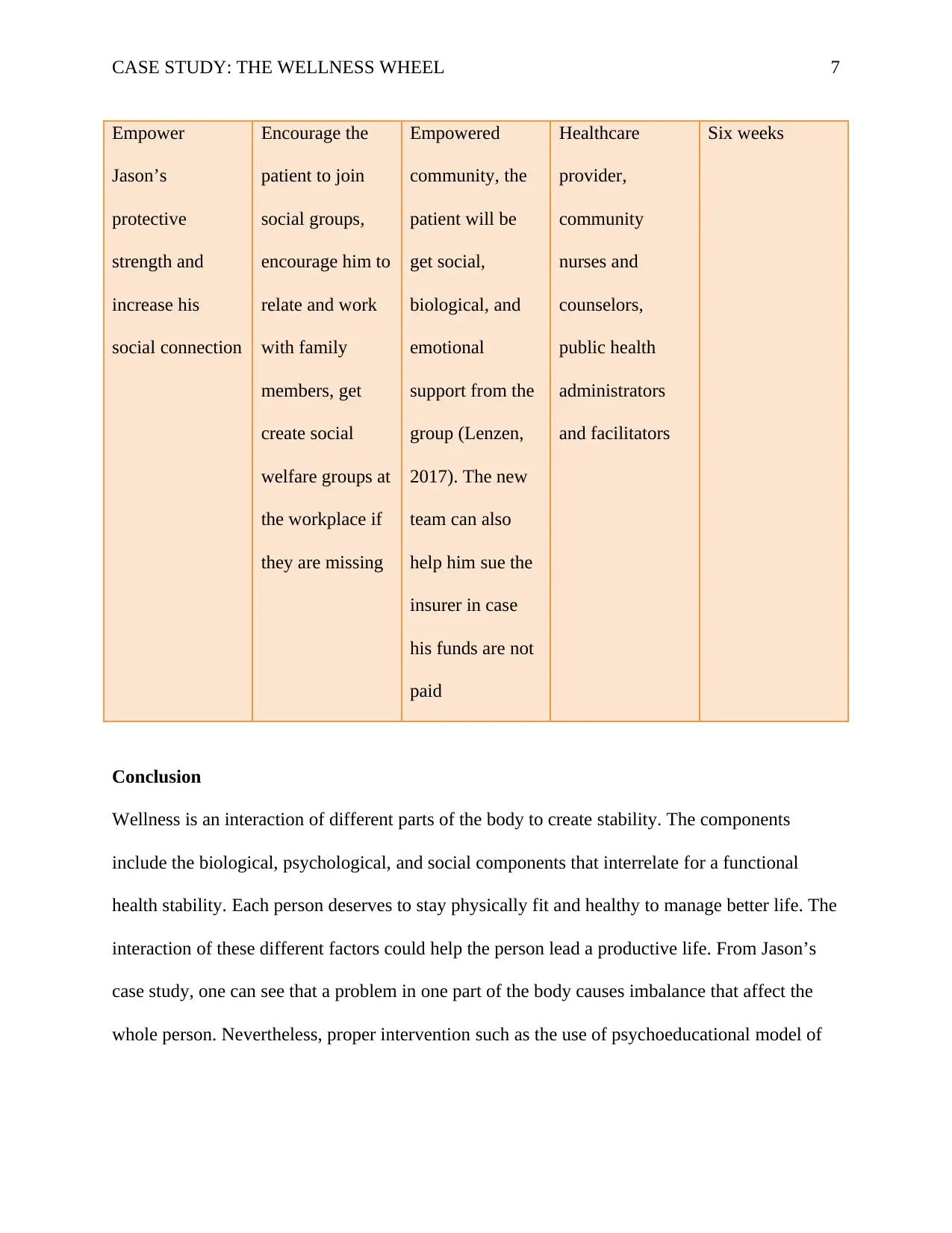
CASE STUDY: THE WELLNESS WHEEL 7
Empower
Jason’s
protective
strength and
increase his
social connection
Encourage the
patient to join
social groups,
encourage him to
relate and work
with family
members, get
create social
welfare groups at
the workplace if
they are missing
Empowered
community, the
patient will be
get social,
biological, and
emotional
support from the
group (Lenzen,
2017). The new
team can also
help him sue the
insurer in case
his funds are not
paid
Healthcare
provider,
community
nurses and
counselors,
public health
administrators
and facilitators
Six weeks
Conclusion
Wellness is an interaction of different parts of the body to create stability. The components
include the biological, psychological, and social components that interrelate for a functional
health stability. Each person deserves to stay physically fit and healthy to manage better life. The
interaction of these different factors could help the person lead a productive life. From Jason’s
case study, one can see that a problem in one part of the body causes imbalance that affect the
whole person. Nevertheless, proper intervention such as the use of psychoeducational model of
Empower
Jason’s
protective
strength and
increase his
social connection
Encourage the
patient to join
social groups,
encourage him to
relate and work
with family
members, get
create social
welfare groups at
the workplace if
they are missing
Empowered
community, the
patient will be
get social,
biological, and
emotional
support from the
group (Lenzen,
2017). The new
team can also
help him sue the
insurer in case
his funds are not
paid
Healthcare
provider,
community
nurses and
counselors,
public health
administrators
and facilitators
Six weeks
Conclusion
Wellness is an interaction of different parts of the body to create stability. The components
include the biological, psychological, and social components that interrelate for a functional
health stability. Each person deserves to stay physically fit and healthy to manage better life. The
interaction of these different factors could help the person lead a productive life. From Jason’s
case study, one can see that a problem in one part of the body causes imbalance that affect the
whole person. Nevertheless, proper intervention such as the use of psychoeducational model of
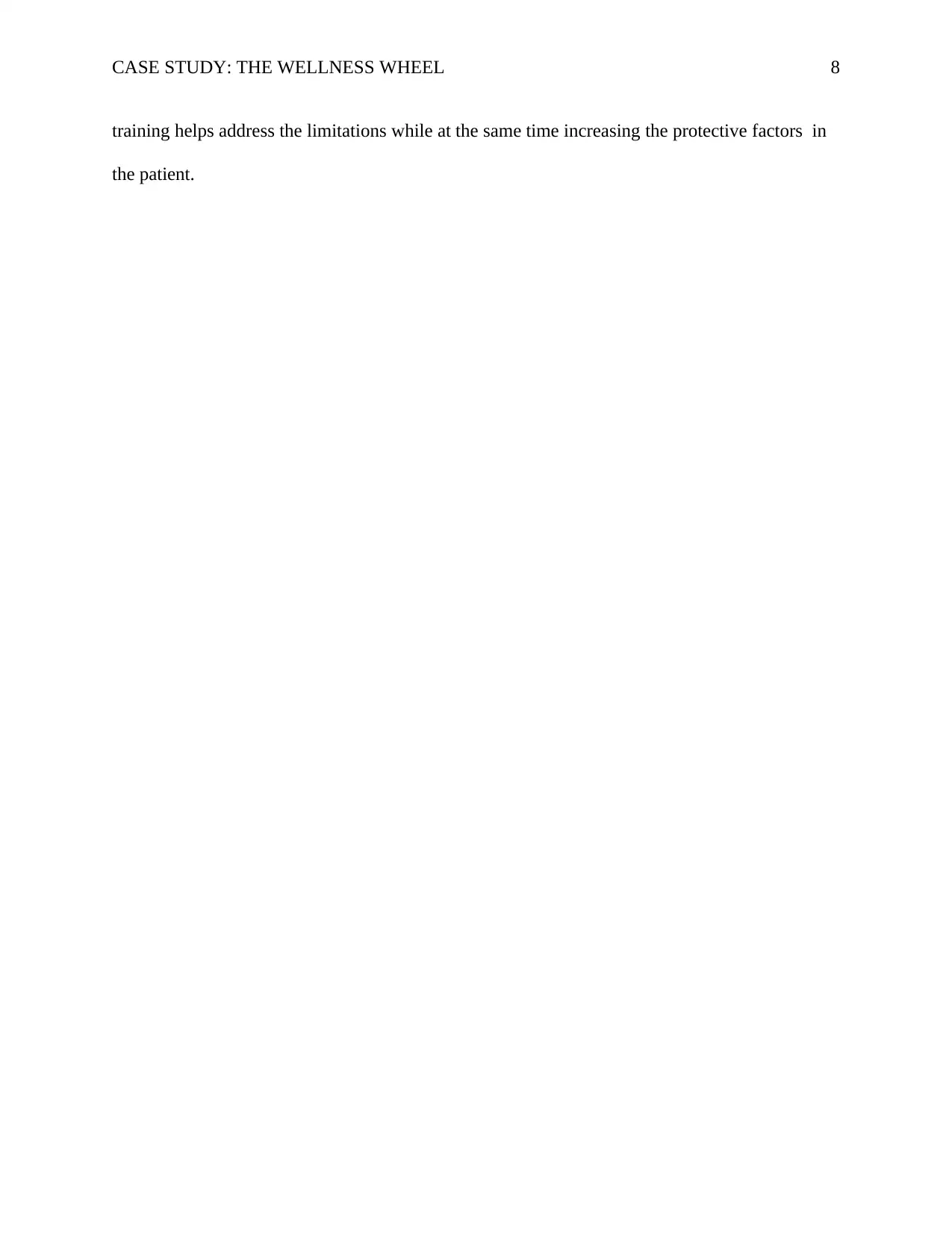
CASE STUDY: THE WELLNESS WHEEL 8
training helps address the limitations while at the same time increasing the protective factors in
the patient.
training helps address the limitations while at the same time increasing the protective factors in
the patient.
⊘ This is a preview!⊘
Do you want full access?
Subscribe today to unlock all pages.

Trusted by 1+ million students worldwide
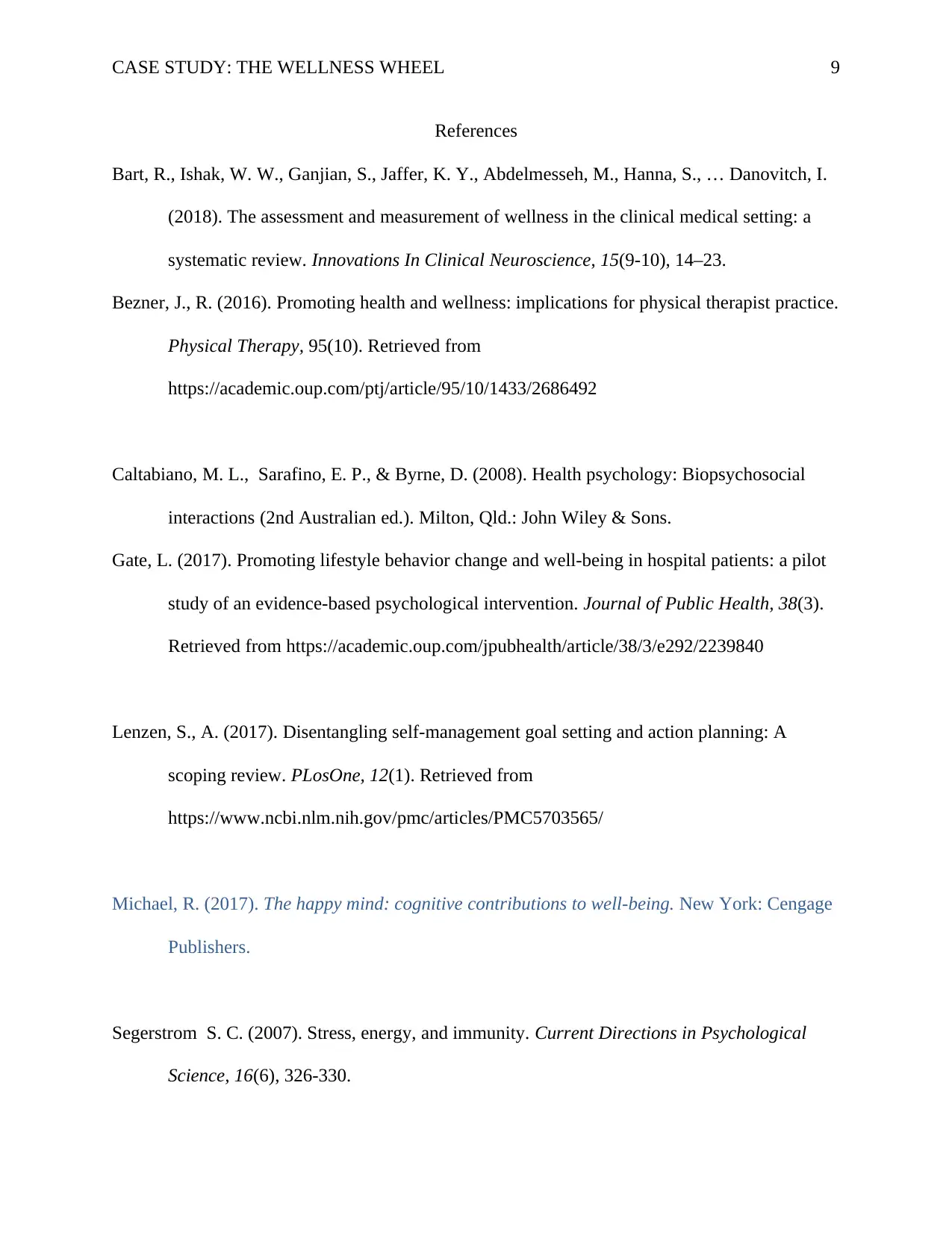
CASE STUDY: THE WELLNESS WHEEL 9
References
Bart, R., Ishak, W. W., Ganjian, S., Jaffer, K. Y., Abdelmesseh, M., Hanna, S., … Danovitch, I.
(2018). The assessment and measurement of wellness in the clinical medical setting: a
systematic review. Innovations In Clinical Neuroscience, 15(9-10), 14–23.
Bezner, J., R. (2016). Promoting health and wellness: implications for physical therapist practice.
Physical Therapy, 95(10). Retrieved from
https://academic.oup.com/ptj/article/95/10/1433/2686492
Caltabiano, M. L., Sarafino, E. P., & Byrne, D. (2008). Health psychology: Biopsychosocial
interactions (2nd Australian ed.). Milton, Qld.: John Wiley & Sons.
Gate, L. (2017). Promoting lifestyle behavior change and well-being in hospital patients: a pilot
study of an evidence-based psychological intervention. Journal of Public Health, 38(3).
Retrieved from https://academic.oup.com/jpubhealth/article/38/3/e292/2239840
Lenzen, S., A. (2017). Disentangling self-management goal setting and action planning: A
scoping review. PLosOne, 12(1). Retrieved from
https://www.ncbi.nlm.nih.gov/pmc/articles/PMC5703565/
Michael, R. (2017). The happy mind: cognitive contributions to well-being. New York: Cengage
Publishers.
Segerstrom S. C. (2007). Stress, energy, and immunity. Current Directions in Psychological
Science, 16(6), 326-330.
References
Bart, R., Ishak, W. W., Ganjian, S., Jaffer, K. Y., Abdelmesseh, M., Hanna, S., … Danovitch, I.
(2018). The assessment and measurement of wellness in the clinical medical setting: a
systematic review. Innovations In Clinical Neuroscience, 15(9-10), 14–23.
Bezner, J., R. (2016). Promoting health and wellness: implications for physical therapist practice.
Physical Therapy, 95(10). Retrieved from
https://academic.oup.com/ptj/article/95/10/1433/2686492
Caltabiano, M. L., Sarafino, E. P., & Byrne, D. (2008). Health psychology: Biopsychosocial
interactions (2nd Australian ed.). Milton, Qld.: John Wiley & Sons.
Gate, L. (2017). Promoting lifestyle behavior change and well-being in hospital patients: a pilot
study of an evidence-based psychological intervention. Journal of Public Health, 38(3).
Retrieved from https://academic.oup.com/jpubhealth/article/38/3/e292/2239840
Lenzen, S., A. (2017). Disentangling self-management goal setting and action planning: A
scoping review. PLosOne, 12(1). Retrieved from
https://www.ncbi.nlm.nih.gov/pmc/articles/PMC5703565/
Michael, R. (2017). The happy mind: cognitive contributions to well-being. New York: Cengage
Publishers.
Segerstrom S. C. (2007). Stress, energy, and immunity. Current Directions in Psychological
Science, 16(6), 326-330.
Paraphrase This Document
Need a fresh take? Get an instant paraphrase of this document with our AI Paraphraser
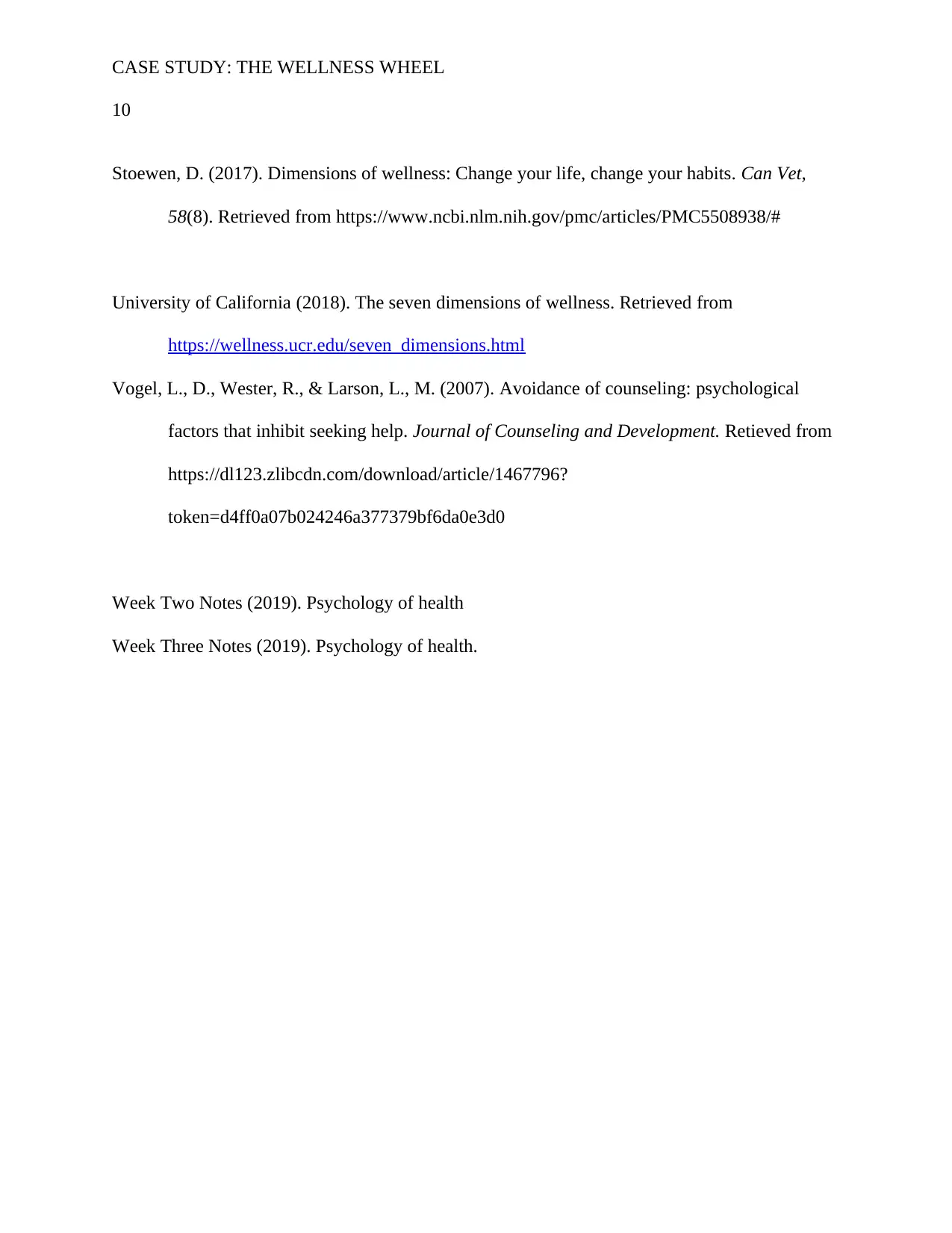
CASE STUDY: THE WELLNESS WHEEL
10
Stoewen, D. (2017). Dimensions of wellness: Change your life, change your habits. Can Vet,
58(8). Retrieved from https://www.ncbi.nlm.nih.gov/pmc/articles/PMC5508938/#
University of California (2018). The seven dimensions of wellness. Retrieved from
https://wellness.ucr.edu/seven_dimensions.html
Vogel, L., D., Wester, R., & Larson, L., M. (2007). Avoidance of counseling: psychological
factors that inhibit seeking help. Journal of Counseling and Development. Retieved from
https://dl123.zlibcdn.com/download/article/1467796?
token=d4ff0a07b024246a377379bf6da0e3d0
Week Two Notes (2019). Psychology of health
Week Three Notes (2019). Psychology of health.
10
Stoewen, D. (2017). Dimensions of wellness: Change your life, change your habits. Can Vet,
58(8). Retrieved from https://www.ncbi.nlm.nih.gov/pmc/articles/PMC5508938/#
University of California (2018). The seven dimensions of wellness. Retrieved from
https://wellness.ucr.edu/seven_dimensions.html
Vogel, L., D., Wester, R., & Larson, L., M. (2007). Avoidance of counseling: psychological
factors that inhibit seeking help. Journal of Counseling and Development. Retieved from
https://dl123.zlibcdn.com/download/article/1467796?
token=d4ff0a07b024246a377379bf6da0e3d0
Week Two Notes (2019). Psychology of health
Week Three Notes (2019). Psychology of health.
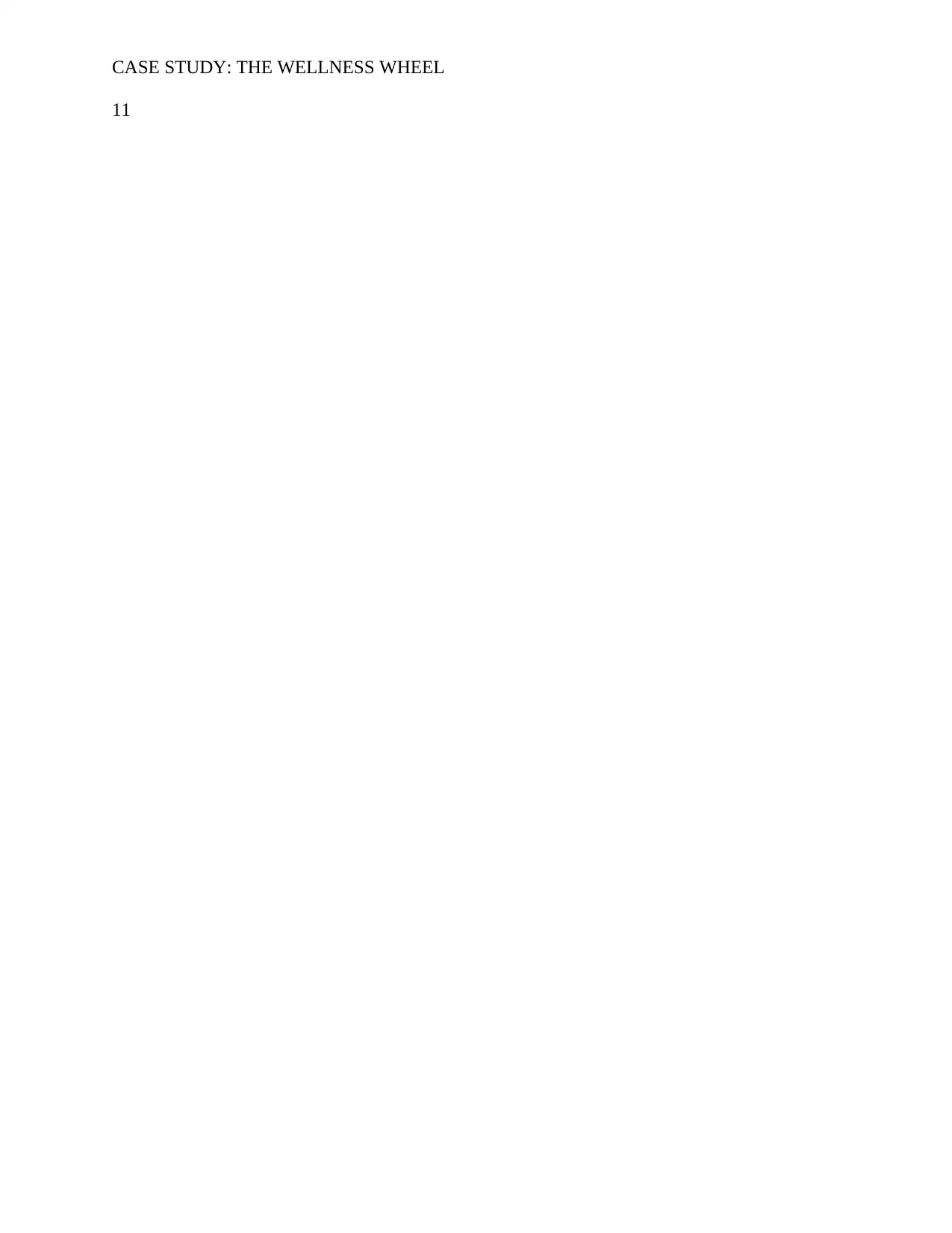
CASE STUDY: THE WELLNESS WHEEL
11
11
⊘ This is a preview!⊘
Do you want full access?
Subscribe today to unlock all pages.

Trusted by 1+ million students worldwide
1 out of 12
Related Documents
Your All-in-One AI-Powered Toolkit for Academic Success.
+13062052269
info@desklib.com
Available 24*7 on WhatsApp / Email
![[object Object]](/_next/static/media/star-bottom.7253800d.svg)
Unlock your academic potential
Copyright © 2020–2025 A2Z Services. All Rights Reserved. Developed and managed by ZUCOL.




